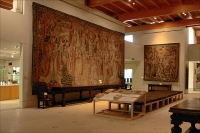
Glasgow's top cultural attraction was donated by the shipping magnate Sir William Burrell in 1944. Over his lifetime, Burrell amassed more than 8,000 works of art. The collection includes hundreds of sculptures, drawings and paintings from the 15th century to the present, some notable medieval European tapestries, as well as artefacts from Arabia and the Orient. The collection is housed in a functional, purpose-built building set in the sedate surroundings of Pollok Country Park.Although it may seem unassuming, the building was meticulously designed to showcase the collection and complement the natural landscape. Within walking distance of The Burrell is Pollok House, which contains a fine collection of Spanish paintings including works by Goya, Murillo and El Greco. The Edwardian house is the ancestral home of the Maxwell family, who donated the house and the collection to the National Trust in 1966.Currently undergoing extensive renovations, the Burrel Collection is set to reopen in 2020. The changes to the museum will increase its floor space fourfold, allowing 90% of Burrel's collection to be on display at any given time.
Address : 2060 Pollokshaws Road, Pollok Country Park
E-mail : [email protected]
Website : www.glasgowlife.org.uk/museums/burrell-collection/Pages/default.aspx
Telephone : (0)141 287 2550
Transport : Train from Glasgow Central to Pollokshaws West; or public bus 45, 47, 48 or 57
Opening times : Monday to Thursday and Saturday 10am to 5pm, Friday and Sunday 11am to 5pm.
Admission : Free admission
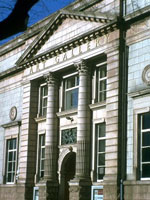
Located in a former Grecian-style mansion near George Square and Buchanan Street, the Gallery of Modern Art (GoMA) displays Glasgow's extraordinary range of post-war art and design. Opened in 1996, the gallery includes works by Niki de Saint Phalle, David Hockney, Sebastiao Salgado, Andy Warhol and Eduard Bersudsky as well as Scottish artists such as John Bellany and Ken Curry. GoMA is Scotland's most visited modern art gallery, and is conveniently located in Royal Exchange Square, in the heart of the city.The permanent collection tends to divide visitors, with hugely varied reviews of the museum from tourists, with some visitors finding it fascinating, inspiring and edgy, while others lament the lack of 'real art'. The statue of the Duke of Wellington with a traffic cone on its head, just outside the museum, has become rather iconic. There is free internet access in the museum and an impressive library, with an extensive collection of art and design books and a simple cafe. The gallery hosts special events and exhibitions throughout the year; check the official website to see what is on during your visit.
Address : Royal Exchange Square
E-mail : [email protected]
Website : www.glasgowlife.org.uk/museums/GoMA/Pages/default.aspx
Telephone : (0)141 287 3050
Transport : Within walking distance of Buchanan Street and St Enoch underground stations
Opening times : Monday, Tuesday, Wednesday and Saturday 10am to 5pm, Thursday 10am to 8pm, Friday and Sunday 11am to 5pm
Admission : Free admission
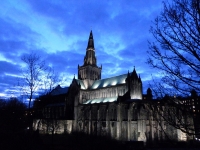
The history of the city of Glasgow is intimately linked to that of the Glasgow Cathedral, as it was the city's patron saint, St Mungo, who oversaw its original construction. The Saint's remains are buried in the cathedral's crypt, and the cathedral itself continues to form a vital part of the religious life of the city of Glasgow. The church has now been in constant use as a place of worship for a remarkable 800 years and its age is palpable. The cathedral's age is all the more remarkable considering how many of Scotland's churches were destroyed during the Reformation.The impressive medieval building, which dates back to the late 12th century, is one of the best examples of Scottish Gothic architecture you'll find anywhere in the country, featuring vaulted arches, stained glass, and spires that have been beautifully blackened with age. A highly recommended activity for tourists in Glasgow, take about an hour to explore the Cathedral's quiet, serene and splendid interior. Guide books in English, French, German, Italian and Spanish are available at the cathedral and simple leaflets are available in 12 different languages. Guided tours can be arranged, although this service is more limited in the winter months.
Address : Cathedral Square, Castle Street, Glasgow
E-mail : [email protected]
Website : www.glasgowcathedral.org/
Telephone : 0141 552 8198
Opening times : In summer (April to September): Open Monday to Saturday from 9.30am to 5.30pm, on Sundays from 1pm to 5pm. In winter (October to March): Open Monday to Saturday from 9.30am to 4.30pm, and on Sundays from 1pm to 4.30pm. Last admission to the Cathedral is always 30 minutes before the closing time.
Admission : Free admission, though donations are appreciated
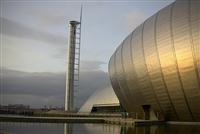
One of the city's premier tourist spots, the Glasgow Science Centre is a captivating attraction that will appeal to visitors of all ages. Located in Glasgow's Clyde Waterfront Regeneration area, the Science Centre has been awarded a five-star ranking from VisitScotland, the country's official tourist board. There is much to see and do in the Glasgow Science Centre. The heart of the Centre is its Science Mall, which features hundreds of interactive exhibits spread over three floors.The Science Mall includes fun, hands-on experiences focused on how the body works, perception and illusion, powering the future and quantum technologies, to name a few. The Glasgow Science Centre is also home to an IMAX theatre and Scotland's leading planetarium. A world-class attraction, a trip to the Glasgow Science Centre is a must for visitors to this Scottish city, and an absolute godsend for those travelling with kids. Put aside at least three or four hours to take it all in.
Address : 50 Pacific Quay, Glasgow
E-mail : [email protected].
Website : www.gsc.org.uk
Telephone : 0141 420 5000
Opening times : Open daily, from 10am to 5pm (summer); open Wednesday to Friday from 10am to 3pm, and on weekends from 10am to 5pm (winter).
Admission : Science Mall: £11 (adults), £9 (children). Add-ons available for the IMAX Theatre and planetarium at £2.50 per person
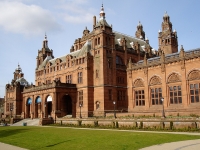
Glasgow's principal art gallery and museum, the Kelvingrove is one of Scotland's most popular free attractions. This imposing red sandstone building, opened in 1901, houses a superb collection of paintings by old masters such as Botticelli, Rembrandt, Monet, Van Gogh and Picasso, as well as an impressive display of European armour, military weapons and prehistoric relics. There are 22 themed galleries containing an incredible 8,000 artefacts and objects from all over the world and covering extremely wide-ranging interests and subjects, ensuring that every visitor should be able to find something that genuinely interests them in the museum.For many people, the main attraction of the permanent collection is a room dedicated to the works of the 19th-century architect Charles Rennie Mackintosh, who studied at the Glasgow School of Art and designed many of the city's great Art Nouveau buildings. The museum also hosts regular temporary exhibitions, for which visitors are usually charged a small entrance fee. There is a pleasant restaurant at the museum, and a shop for souvenirs. Kelvingrove is one of the top attractions in the city and generally receives rave reviews from tourists.
Address : Kelvin Park, Argyle Street
E-mail : [email protected]
Website : www.glasgowlife.org.uk/museums/kelvingrove/Pages/default.aspx
Telephone : +44 141 276 9599
Transport : Kelvinhall underground station. Alternatively, public bus services 9, 16, 18/A, 42/A or 62 all stop directly outside Kelvingrove Museum
Opening times : Open daily, from 10am to 5pm (Monday to Thursday and on Saturdays), from 11am to 5pm (Fridays and Sundays)
Admission : Free admission

Travel Guide powered by Word Travels, copyright © 2023 Globe Media Ltd. By its very nature information in this travel guide is subject to change at short notice and travellers are urged to verify information on which they're relying with the relevant authorities. Neither Globe Media Ltd nor Travel Vogue can accept any responsibility for any loss or inconvenience to any person as a result of information contained above.